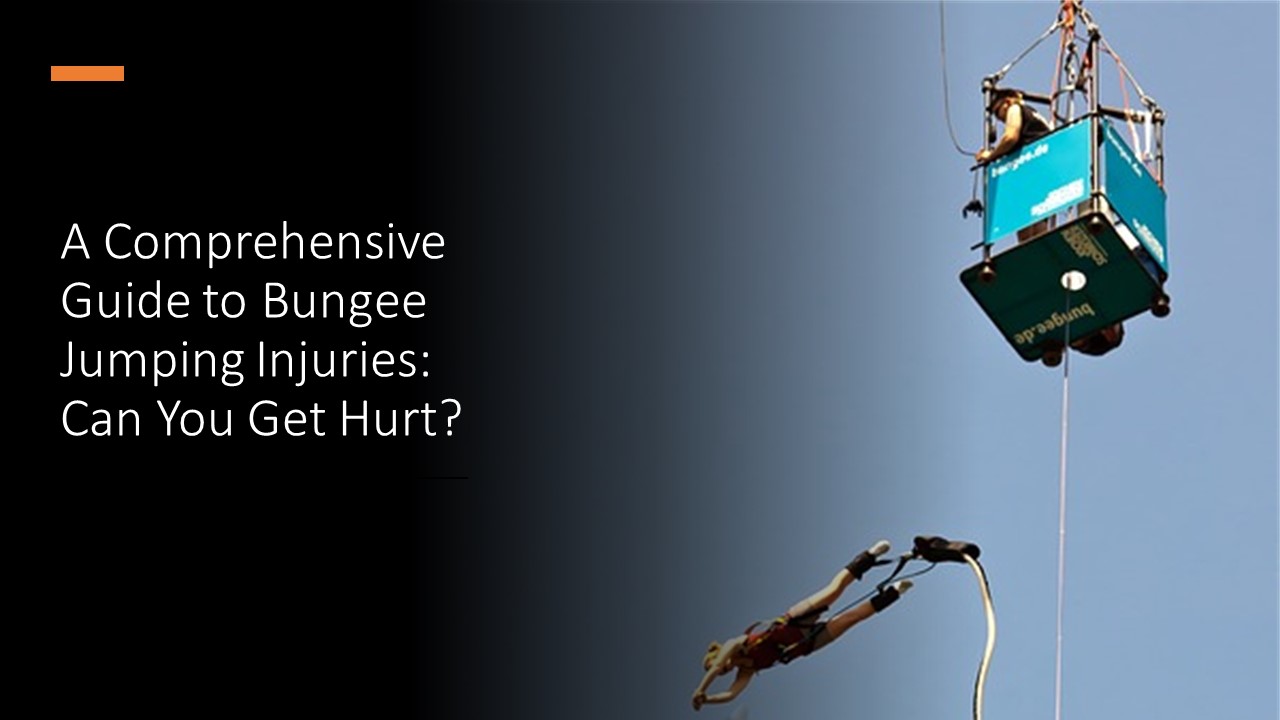Welcome to a heart-pounding and comprehensive guide on bungee jumping injuries. If you’ve ever been curious about the potential risks of bungee jumping or have a desire to take the leap yourself, you’ve come to the right place. As someone who has experienced the exhilaration of bungee jumping firsthand, I understand the mix of excitement and trepidation that comes with it. The common question is can you get hurt while bungee jumping?
Yes, there is a potential risk of getting hurt while bungee jumping. Bungee jumping involves a sudden free fall and rebound, which can put strain on various parts of your body, including your neck, back, and ankles. Whiplash, strains, and sprains are some of the injuries that can occur during the jump. However, it’s important to note that bungee jumping can be safe when conducted with proper safety measures and by reputable operators. Certified bungee jumping companies follow stringent protocols, maintain high-quality equipment, and have experienced jumpmasters who ensure your safety during the entire process.
In this comprehensive guide, I’ll dive headfirst into the world of bungee jumping injuries, discussing everything you need to know before taking that leap of faith. But don’t worry, I’m not here to scare you away from this incredible adventure sport. Instead, I aim to equip you with knowledge that will help you make informed decisions and ensure your safety during this thrilling experience.
Let’s dive right in!
The Thrill of Bungee Jumping
The heart-pounding thrill of bungee jumping! There’s truly nothing quite like it. Picture this: you’re standing on the edge of a towering bridge or platform, your heart racing, your palms a little sweaty, and your adrenaline levels soaring through the roof. The world below seems both incredibly distant and intensely real at the same time. It’s an extraordinary mix of fear and excitement, and you know you’re about to experience something unforgettable.
When I took my first bungee jump, I could feel the rush of emotions surging through me. The jumpmaster gave me a reassuring nod, and without a moment’s hesitation, I took that giant leap into the open air. For a split second, there’s a weightless feeling as you dive down, and then the bungee cord stretches, propelling you back up. The sensation is indescribable, and it’s like nothing else matters at that moment. It’s just you, the bungee, and the incredible force of gravity.
As you’re suspended mid-air, you can’t help but feel a tremendous sense of accomplishment. You’ve conquered your fears, embraced the unknown, and taken a leap that most people only dream of. Bungee jumping is an adventure like no other, and it has a way of leaving you with memories that last a lifetime.
But why do we seek out these adrenaline-packed experiences? Well, it’s simple – the thrill of bungee jumping is addictive. It pushes us beyond our comfort zones and teaches us that we’re capable of so much more than we think. There’s an innate desire to test our limits and experience that extraordinary rush that comes from defying gravity.
Moreover, bungee jumping has become increasingly popular over the years, with numerous scenic locations around the world offering this ultimate adventure. From iconic bridges to towering cliffs and even purpose-built platforms, the variety of jumping spots adds to the excitement and allure of the sport.
However, with this incredible thrill comes a responsibility to stay safe. It’s vital to understand that bungee jumping, like any adventure sport, comes with its fair share of risks. We’ll delve into those risks in detail later on, but rest assured, it’s possible to enjoy this heart-stopping activity while minimizing the potential for injuries.
So, if you’ve been considering bungee jumping or you’re simply curious about the experience, keep reading! I’ll walk you through the safety measures, potential injuries, and everything you need to know to make your bungee jumping journey as exhilarating and safe as possible. Let’s continue this thrilling adventure together!
Understanding the Safety Measures
When it comes to bungee jumping, safety is of utmost importance. Before you leap into the void, it’s essential to understand the stringent safety measures put in place by professional bungee jumping operators to ensure your well-being throughout the entire experience.
- Certified Bungee Jumping Companies: First and foremost, always choose a reputable and certified bungee jumping company. Look for operators with a proven track record, positive reviews, and adherence to safety standards. A trustworthy operator will have experienced jumpmasters, well-maintained equipment, and a comprehensive safety protocol.
- Proper Equipment: The bungee jumping gear plays a pivotal role in your safety. Before you jump, the jumpmaster will securely fasten a harness and a bungee cord to your ankles or body. Ensure that all equipment is in excellent condition, and don’t hesitate to ask the staff any questions or express concerns about the gear.
- Double-Checking Procedures: Professional bungee jumping companies have strict double-checking procedures in place. Before you jump, the jumpmaster and a colleague will carefully inspect all equipment, ensuring it’s correctly attached and functioning correctly. This double-checking process minimizes the risk of any oversight.
- Weight Limits and Health Checks: Bungee jumping operators have weight limits to ensure the equipment can safely support the jumper’s weight. It’s essential to be honest about your weight to prevent any issues during the jump. Additionally, some companies may conduct health checks to ensure that you don’t have any medical conditions that could pose a risk during the jump.
- Jumpmaster’s Instructions: Listen carefully to the jumpmaster’s instructions. They are highly trained professionals who know the ropes, quite literally! They will guide you on how to position yourself before the jump and ensure you follow the necessary safety protocols.
- Cord Length Calculation: The length of the bungee cord is crucial in determining a safe jump. Professional bungee jumping companies meticulously calculate the correct cord length to allow for a controlled deceleration during the fall and rebound. This calculation is based on your weight and the distance to the ground or water.
- Site Inspections: Reputable operators conduct regular inspections of their jumping locations to ensure the structural integrity and safety of the jumping platform. They also assess the environment for any potential hazards.
- Weather Conditions: Bungee jumping is weather-dependent. Operators monitor weather conditions closely and may suspend or cancel jumps if conditions are unsafe. While this may be disappointing, it’s essential to prioritize safety over the thrill.
Remember, the professionals overseeing your bungee jumping experience are trained to handle various situations and prioritize your safety above all else. Trust in their expertise and adhere to their instructions to make the most of this thrilling adventure while minimizing any potential risks. Now that I’ve covered safety measures let’s move on to explore the possible injuries you might encounter during a bungee jump.
Potential Injuries: Know the Risks
Before you take that leap of faith, it’s essential to be aware of the potential injuries that can occur during a bungee jump. While bungee jumping can be an exhilarating experience, like any adventure sport, it does come with its share of risks. Knowing these risks will help you make an informed decision and take the necessary precautions for a safe and enjoyable jump.
1. Physical Injuries
Whiplash and Neck Strains: During the initial fall and rebound, sudden deceleration and acceleration can put a strain on your neck. Whiplash injuries are not uncommon, especially if your body isn’t adequately positioned during the jump.
Tip: To minimize the risk of neck injuries, keep your head aligned with your body, and avoid overextending your neck. Maintain a relaxed posture during the jump.
Back Injuries
The force of the bungee cord as it stretches and recoils can also impact your back. Improper landing or an uncontrolled bounce may lead to strains or sprains.
Tip: Before the jump, do some light warm-up exercises to prepare your back muscles. And when you land, try to bend your knees slightly to absorb the impact.
Ankle and Leg Sprains: The landing impact can also affect your ankles and legs, potentially leading to sprains if you don’t land correctly.
Tip: Pay attention to the jumpmaster’s instructions on how to land, and ensure your ankles are properly secured in the harness.
2. Medical Conditions and Health Risks
Bungee jumping can cause a sudden increase in heart rate and blood pressure. Individuals with pre-existing heart conditions or high blood pressure may be at higher risk during the jump.
Tip: If you have any heart concerns, consult your doctor before attempting a bungee jump. Your safety should be the top priority.
High Blood Pressure: Even if you don’t have a known heart condition, bungee jumping can temporarily raise your blood pressure. For individuals with hypertension, this increased pressure can be risky.
Tip: If you have high blood pressure, it’s best to avoid bungee jumping or any activity that could further raise your blood pressure.
3. Pregnant Women and Bungee Jumping
Bungee jumping is an absolute no-go during pregnancy. The risks associated with the sudden jolt and the increased pressure on the body could harm both the mother and the unborn child.
Tip: Expecting mothers should steer clear of bungee jumping and opt for alternative, pregnancy-safe adventures.
4. Psychological Impact
Fear and Anxiety: It’s completely natural to feel fear and anxiety before a bungee jump. Fear of heights and the unknown can be overwhelming.
Tip: Embrace the fear and use it to fuel your courage. Engage in mental preparation techniques like visualization and positive affirmations to calm your nerves.
Post-Jump Emotional Response
After the jump, you might experience a mix of emotions, ranging from euphoria to vulnerability.
Tip: Give yourself time to process these emotions, and don’t hesitate to share your feelings with friends, family, or fellow jumpers who can relate.
Understanding these potential injuries and risks will help you approach bungee jumping with a sense of awareness and responsibility. The next section will focus on minimizing these risks and ensuring you have a safe and enjoyable bungee jumping experience.
Who Should NOT Do Bungee Jumping: A Comprehensive Guide for Safety
Minimizing the Risks
Minimizing the risks associated with bungee jumping is essential to ensure a safe and enjoyable experience. While it’s impossible to completely eliminate all risks, following these guidelines will significantly reduce the likelihood of injuries and help you make the most of this thrilling adventure:
- Choose a Reputable Bungee Jumping Company: Opt for a certified and well-established bungee jumping operator with a proven safety record. Research online reviews and recommendations to find a trustworthy company that prioritizes safety.
- Listen to Your Jumpmaster: Pay close attention to the instructions provided by the jumpmaster before the jump. They are highly trained professionals who know how to ensure a safe experience. Follow their guidance on body positioning, landing technique, and overall safety protocols.
- Assess Your Physical and Medical Condition: Before committing to a bungee jump, honestly assess your physical fitness and medical condition. If you have any pre-existing medical conditions, especially heart-related issues or high blood pressure, consult your doctor beforehand to ensure your safety.
- Stay Within Weight Limits: Adhere to the weight restrictions set by the bungee jumping company. These limits are in place to ensure the bungee cord can handle the force of your fall and rebound.
- Prepare Your Body: Engage in light warm-up exercises before the jump to prepare your muscles and reduce the risk of strains or sprains. Focus on exercises that target your neck, back, and leg muscles.
- Follow Weather Guidelines: Bungee jumping is weather-dependent, and operators monitor conditions closely. Trust their judgment and avoid jumping in adverse weather, such as strong winds or storms.
- Be Mindful of Your Mental State: Acknowledge any fear or anxiety you might feel before the jump. It’s entirely normal and a part of the adventure. Engage in relaxation techniques like deep breathing and visualization to calm your nerves.
- Respect Your Personal Limits: While bungee jumping pushes you out of your comfort zone, know your limits and don’t feel pressured to take a jump if you’re not ready. Listen to your instincts and make the decision that feels right for you.
- Avoid Overexertion: Take it easy after the jump and avoid engaging in strenuous activities immediately afterward. Your body needs time to recover from the excitement and potential physical strain.
- Follow Aftercare Instructions: After the jump, listen to any aftercare instructions provided by the jumpmaster. Attend to any minor injuries or discomfort promptly, and seek medical attention if needed.
Remember, bungee jumping is an adventure that requires a balance of excitement and caution. With the right preparation and mindset, you’re sure to have an unforgettable and safe experience that will leave you with memories to cherish for a lifetime!
Aftercare and Recovery
After you’ve experienced the incredible rush of bungee jumping, it’s essential to focus on aftercare and recovery to ensure your body and mind have a smooth transition back to solid ground. While bungee jumping is generally safe when done correctly, your body may still need some care and attention after the adrenaline has settled. Here are 9 aftercare tips to help you recover and stay in top shape:
- Rest and Hydration: Take some time to rest after your bungee jump. The adrenaline rush and excitement can leave you feeling drained, so make sure to get plenty of sleep and stay hydrated. Drink water or hydrating fluids to replenish your body after intense physical activity.
- Address Any Minor Injuries: Check for any minor injuries or soreness that may have occurred during the jump. Treat any bruises, scratches, or strains with appropriate first aid measures, such as applying ice or using topical creams.
- Avoid Strenuous Activities: Give your body some time to recover by avoiding strenuous physical activities immediately after the jump. Your muscles might be sore, and you don’t want to risk aggravating any minor injuries.
- Maintain a Healthy Diet: Nourish your body with a balanced diet rich in nutrients. Incorporate fruits, vegetables, and protein to support your body’s recovery process.
- Embrace Self-Care: Take care of your mental well-being too. Allow yourself to process the emotions that come after such an intense experience. Reach out to friends or fellow jumpers to share your feelings and relive the adventure.
- Soothe Your Nerves: Some people might experience post-jump anxiety or have lingering nerves. Engage in relaxation techniques like deep breathing or meditation to help soothe your mind.
- Seek Medical Attention If Necessary: If you’re experiencing any persistent discomfort or if a minor injury worsens, don’t hesitate to seek medical attention. Your health and well-being are top priorities.
- Gradually Return to Regular Activities: As your body feels better, ease back into your regular activities. Pay attention to how your muscles and joints respond and adjust your pace accordingly.
- Cherish the Memories: Take time to relive the unforgettable moments of your bungee jump. Capture the experience in photographs or videos and keep them as souvenirs of your brave adventure.
Everyone’s body responds differently to intense experiences like bungee jumping. Listen to your body and give it the time and care it needs to recover fully. If you feel unsure or notice any unusual discomfort, don’t hesitate to consult a medical professional.
Bungee jumping is an exhilarating and memorable adventure, and with proper aftercare and recovery, you’ll be back on your feet, ready to take on your next thrilling challenge.
Conclusion
In conclusion, bungee jumping is undoubtedly an adventure that offers an unparalleled rush and a chance to conquer your fears. You’ve explored the thrill of bungee jumping, the potential injuries and risks involved, safety measures to ensure a safe jump, and the importance of aftercare and recovery. Armed with this knowledge, you are now well-equipped to make an informed decision before taking the leap.
The best answer to the question “Can you get hurt while bungee jumping?” I can confidently say that yes, there are potential risks and injuries associated with bungee jumping. However, it’s crucial to recognize that these risks can be significantly minimized by choosing a reputable bungee jumping company, following safety protocols, being aware of your physical and medical condition, and taking care of yourself after the jump.
While bungee jumping does come with potential risks, it’s essential to note that reputable bungee jumping companies prioritize safety and have strict measures in place to minimize these risks. The injuries discussed, such as whiplash, back strains, and ankle sprains, are relatively uncommon when proper safety precautions are followed. Additionally, the risk of severe injuries is significantly reduced when using certified and experienced jumpmasters and adhering to weight limits.
Moreover, the risks associated with bungee jumping should not overshadow the exhilaration and sense of achievement that come with taking the leap. The vast majority of bungee jumps occur without incident, and millions of people around the world have safely enjoyed this thrilling adventure sport.
As with any adventure activity, there is an element of risk involved, but bungee jumping remains a safe and well-regulated activity when conducted with certified operators and responsible individuals. Always prioritize your safety and the safety measures put in place by professionals to ensure a memorable and enjoyable bungee jumping experience.
Thanks for reading and happy jumping!
I recommend you to read this article next: Bungee Jumping: The Do’s And Don’ts For An Epic Adventure










